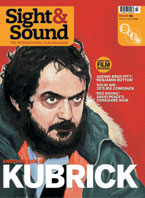Primary navigation


Kubrick's unmade 1990s project Aryan Papers has now inspired an intriguing installation by the Wilson Twins that finally gives its star her moment. ByBrian Dillon
The films and installations of Jane and Louise Wilson essay a sort of time travel, surveying the ruins of the 20th century in search of those anecdotes and artefacts that seem to project themselves into impossible futures. Theirs is an art of anachronism, of objects and places that have lived too long, yet whose once utopian urges are still unfulfilled.
In Dream Time (2001), they filmed the launch of the first manned Russian mission to the International Space Station; the machinery of the ex-Soviet state looked ancient and obsolete, conjuring the dual ghosts of Cold War rivalry and post-war internationalism.
In the multi-screen installation A Free and Anonymous Monument (2003), their camera swoopingly explored the Apollo Pavilion, Victor Pasmore's architectonic sculpture for the new town of Peterlee. Built in the 1960s and decayed to a grey concrete hulk, the structure leached lost hope.
This interest in relics of futures past, and the Wilson twins' sinuous and ravishing cinematography, led Animate Projects to commission them to create a response to the Stanley Kubrick Archive, now overseen by the University of Arts, London. The director's vast accumulation of research and reference materials for his films was previously housed at his estate in Hertfordshire, where it might have made a fittingly melancholy addition to the Wilsons' oeuvre: "That's the only time we'd have thought to film it, when it was in that state," says Jane. Installed at its new state-of-the-art home, it was the archived content that intrigued the artists during the ten days' research time allowed. According to Louise: "The sheer breadth of material for each project meant we weren't going to be able to tackle all of that in ten days."
Instead of attempting a portrait of the archive as such, they focused on material relating to Aryan Papers, Kubrick's unmade film of Louis Begley's 1991 novel Wartime Lies, the story of a young Jewish woman, Tania, and her little nephew, who pass themselves off as Catholics in Nazi-occupied Poland. Kubrick had begun to conceive a film about the Holocaust in the late 1970s and gradually amassed an astonishing amount of material dedicated, as Jane puts it, simply to "seeing what things would have looked like at the time". Louise recalls: "One of the boxes was labelled 'prams and pushchairs', and you'd see these images of perambulators from the 1930s housing babies… by the early 1940s they're transporting suitcases and possessions. Kubrick employed people to research things like watches, clocks and radios - there's a whole file on those. So much of it comes down to collecting image after image."
Among the mass of photographs, the images that seemed most insistent to the sisters were the wardrobe shots Kubrick had made in the early 1990s of Johanna ter Steege (star of The Vanishing), the Dutch actress who was slated to play Tania. "Johanna talks so passionately and so consumedly about this character, this fictive person that she was meant to portray," says Louise. "She had a strong identification with Tania. She'd thought about it since, obviously: it was devastating at the time for the film not to happen, though she's worked pretty consistently since." A script exists for Aryan Papers - though it would have altered substantially in the shooting - and so it was possible for ter Steege to reacquaint herself, before the Wilsons' camera, with her own lost future.
The resulting film, Unfolding the Aryan Papers, combines stills from Kubrick's meticulous collection - wardrobe shots, photographs from World War II, production stills of the 1940s from the Ealing Studios archive - with footage of ter Steege replicating her character in the corridors and stairwells of Hornsey Town Hall, north London. (The building is well chosen: built by Reginald Uren and opened in 1935, it was the first major modernist building in Britain; when the Wilsons filmed it late last year, it was empty and unused.) The actress revisits Kubrick's script, but also her own reaction to his scrapping the project in 1995: "In the end, when he decided not to do the movie, for two days I stayed in my bed… I thought: this is it. I was very sad, and after two days I got out of my bed and I thought: okay, just go on."
At the time of writing, while they were still editing the film, the Wilsons envisaged Unfolding the Aryan Papers as a single-screen installation, shown on a screen four metres by three in size, flanked by large mirrors to produce an infinity effect. In its convolved and elegant relation to Kubrick's unseen original, the film not only resurrects the dead images in the archive, but inserts its protagonist back into the history she would have been part of - ter Steege would have played the most prominent female character in the Kubrick corpus. As it is, the belated Tania double stands for what might have been: another example of the Wilsons' filmic regeneration programme for the lost hopes of the past, and an intriguingly oblique addition to the archive of Kubrick commentary.
'Unfolding the Aryan Papers' appears at the Gallery at BFI Southbank, London, from 13 February to 26 April